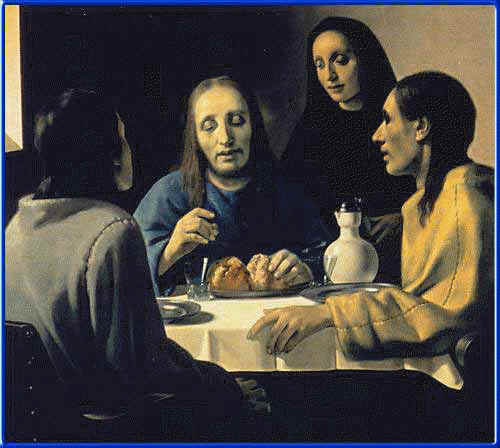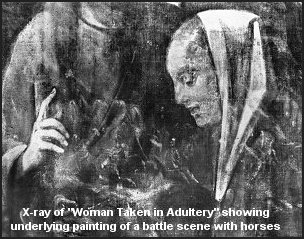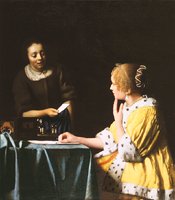The Hans Van Meegeren Forgeries
The forgeries perpetrated by Hans van
Meegeren are probably some of the most famous in the art world. Van
Meegeren did not copy a great painting and try to pass it off as an original but
created new originals of his own. He faked 6 Vermeer's in all, these were
put onto the market as new discoveries.
Discovery
 Van Meegeren
hated the art establishment and a greater embarrassment he could not have hoped
to cause them. The frauds went undetected for ten years until in 1945 Van
Meegeren was arrested as a collaborator of the Germans. He then confessed
to having faked the Vermeer's and was instead charged with fraud. He was
sentenced to a term of one year but died before he could serve it.
Van Meegeren
hated the art establishment and a greater embarrassment he could not have hoped
to cause them. The frauds went undetected for ten years until in 1945 Van
Meegeren was arrested as a collaborator of the Germans. He then confessed
to having faked the Vermeer's and was instead charged with fraud. He was
sentenced to a term of one year but died before he could serve it.
The Forgeries

The picture on the left Christ at Emmaus was
considered by Van Meegeren to be his "masterpiece". He obtained
a genuine 17th century canvas with its original stretcher. He removed the
original composition and cut down the canvas retaining a piece of it. He
then painted his creation on to the authentic canvass.
Other forgeries include The Washing of Christ's Feet,
Christ and the Adulteress and Lady and Gentleman at a Spinet.
Van Meegeren invented an ageing process which was nearly
indistinguishable from the real thing. He ground his pigments in oil of
lilacs and then mixed them with a special medium. This was phenol formaldehyde
resin dissolved in either benzene or turpentine. The painting was then
baked for several hours at a temperature over 100°C. The result was a
paint film which had all the characteristics of a genuine 17th century painting.
Scientific Analysis
Once Van Meegeren had confessed to the fakes a series of
chemical and physical tests were carried out. This was done by Dr P.B.
Coremans the director of the central laboratory of Belgian museums. A
dozen paintings and various materials found at Van Meegeren's studio were
examined.
The paints were all found to contain traces of phenol formaldehyde
resin and traces of cobalt blue were also found in two of the paintings.
Cobalt blue is an artificial pigment not manufactured until the 19th
century.
 X-rays
showed original 17th century pieces under the paintings.
X-rays
showed original 17th century pieces under the paintings.
The piece of canvass kept from Christ in Emmaus
was also found and matched to the canvass used for the painting.
Genuine Vermeer's

Mistress and Maid shown on the right is a genuine
Vermeer. The paintings by Van Meegeren are now considered to be vastly
inferior. Van Meegeren could not accurately depict anatomy or materials
and was not nearly so accomplished a painter as he was a forger.
 Van Meegeren
hated the art establishment and a greater embarrassment he could not have hoped
to cause them. The frauds went undetected for ten years until in 1945 Van
Meegeren was arrested as a collaborator of the Germans. He then confessed
to having faked the Vermeer's and was instead charged with fraud. He was
sentenced to a term of one year but died before he could serve it.
Van Meegeren
hated the art establishment and a greater embarrassment he could not have hoped
to cause them. The frauds went undetected for ten years until in 1945 Van
Meegeren was arrested as a collaborator of the Germans. He then confessed
to having faked the Vermeer's and was instead charged with fraud. He was
sentenced to a term of one year but died before he could serve it.
 X-rays
showed original 17th century pieces under the paintings.
X-rays
showed original 17th century pieces under the paintings.